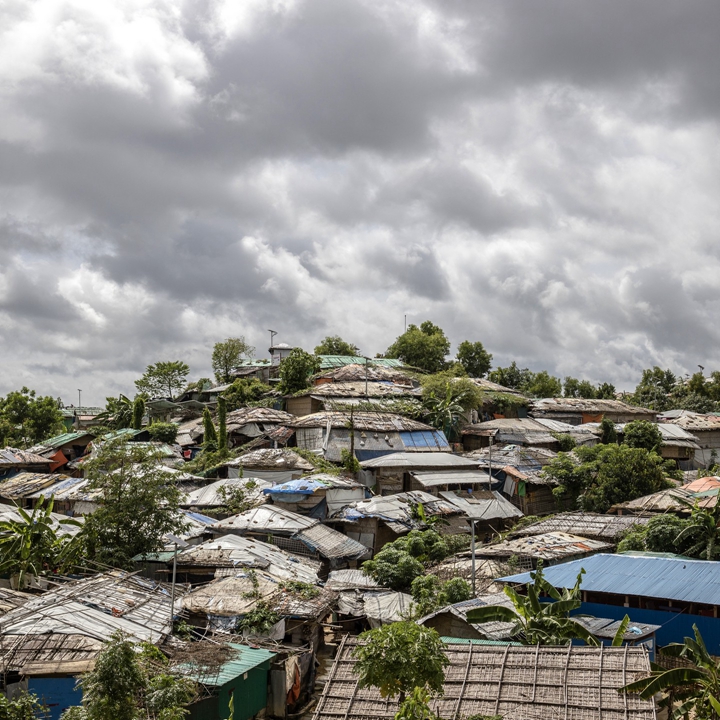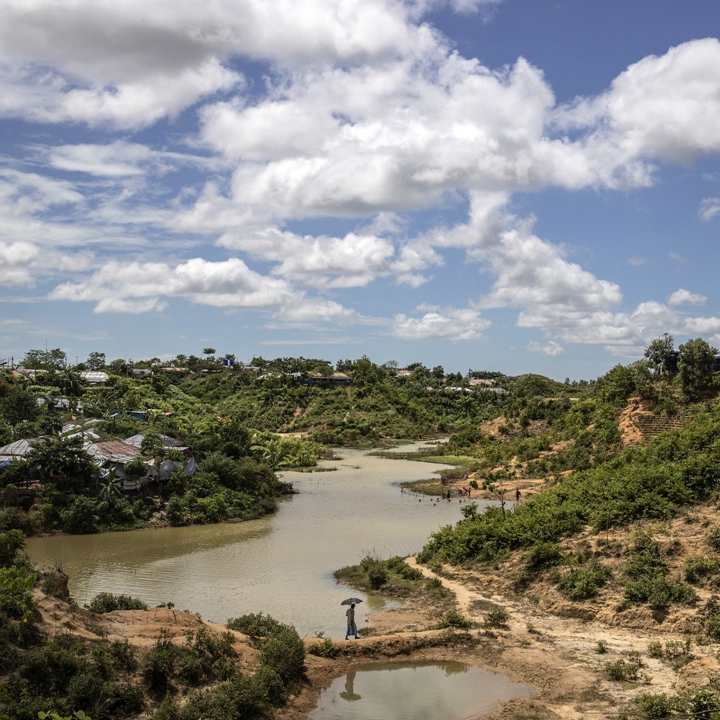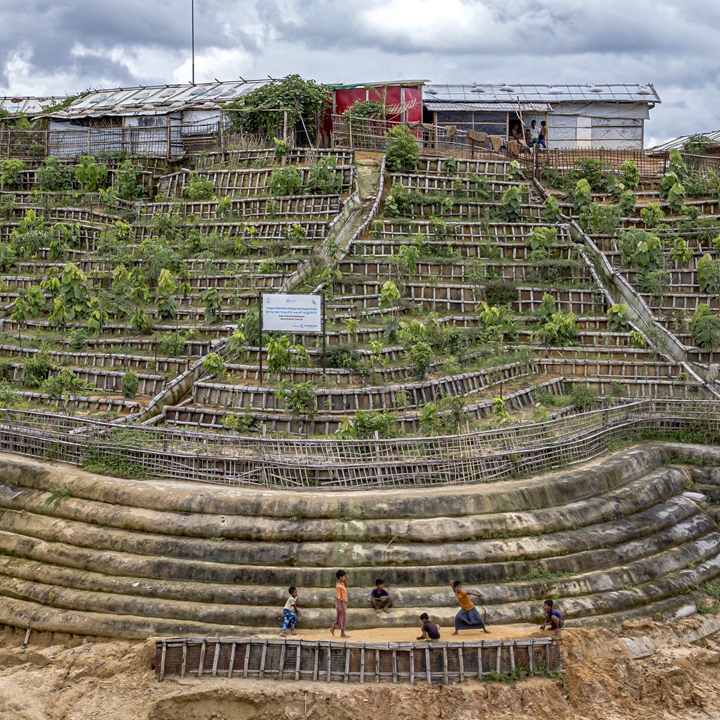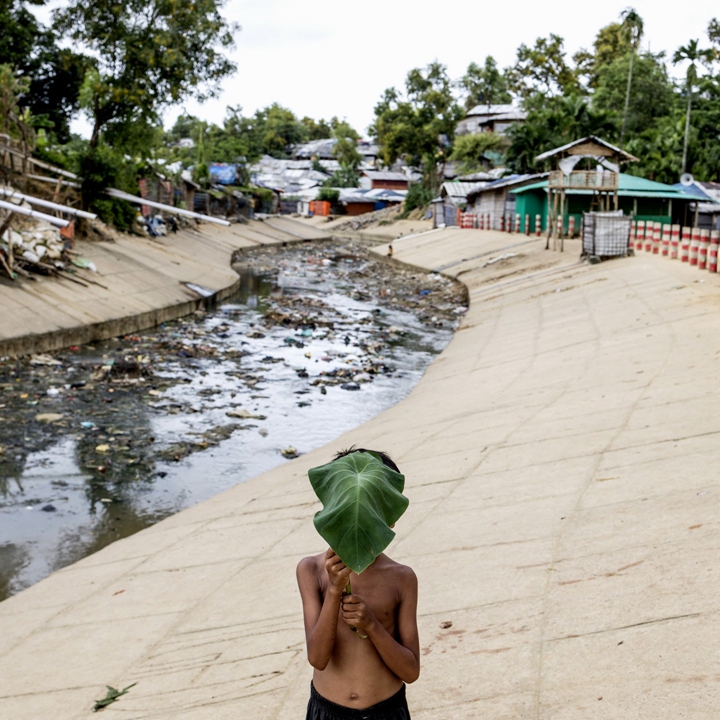The Wretched and the Earth
Text and photos by Gabriele Cecconi/Parallelozero
Abridged by Syharn Shen (沈思含)
The Wretched and the Earth
Text and photos by Gabriele Cecconi/Parallelozero
Abridged by Syharn Shen (沈思含)

A view of a former degraded hill in Balukhali camp in Cox's Bazar, Bangladesh.
In August 2017, approximately 700,000 Rohingya refugees sought shelter in Bangladesh to escape persecution by the Burmese army due to ethnic and religious reasons. Today, about a million people live in the Cox's Bazar district of southern Bangladesh—a lush, rural tongue of land squeezed between the Naf River and the Bay of Bengal, which is home to one of the world's largest and longest sandy marine ecosystems. Before the arrival of the refugees, the peninsular area was home to some 300,000 Bengali, mostly farmers and fishermen.
When I first visited the area in March 2018, I was impressed by the lush landscape and the slowness with which life seemed to flow. Sandy yet densely vegetated hills stood against the backdrop of a flat, fertile landscape in what is one of the most environmentally fragile areas in all of Bangladesh. However, the arrival of Rohingya refugees led to dramatic changes. The government, along with UNHCR and other international organizations, accommodated the refugees across the region, resulting in the establishment of more than 20 refugee camps. The largest of these camps, the Kutupalong-Balukhali refugee campsite, now accommodates over 600,000 people.
When I first arrived at the entrance of the camp, I witnessed a stark scene. The main road, hastily built by the army, led me to a ridge of sandy hills that used to be part of the Teknaf nature reserve. Thousands of makeshift shelters were stacked on top of each other, surrounded by a completely deforested and eroded landscape. The harsh Bengali sun reflected off the bare, sandy soil. The forest had been completely cleared to build the camp, and the impact on the environment was devastating.
In cases of mass migration, such as the Rohingya crisis in Bangladesh, thousands of people converge on a confined area with urgent needs. During the initial emergency phase, these needs clash with the delicate balance of already fragile ecosystems. The pressure on the environment and local resources becomes unsustainable, leading to irreversible changes and the destruction of biodiversity. This, in turn, exacerbates the effects of climate change in the affected areas and poses severe consequences for the refugees themselves.

One of the newest and less densely populated camp of the Balukhali-Kutupalong refugee campsite, Camp 20 Extension was created in 2018 to relocate refugees in other areas or camps who were at risk of landslides.
In Ukhia and Teknaf, more than 8,000 acres of the nature reserve were lost in the first year alone. This was a result of both camp construction and the needs of the population to collect wood for cooking their limited food supplies in cramped and overcrowded shelters. The immediate consequences included deforestation, soil erosion, water resource degradation, and overall loss of biodiversity.
Among the Rohingya refugees, respiratory infections became a leading cause of death as they were in constant exposure to smoke from burning wood for cooking. It was awe-inspiring in the morning at dawn, not only to see the camp covered in a blanket of smoke coming out from hundreds of shelters, but also the queues of thousands of people, men, women and children, venturing outside the camp's boundaries and walking long distances to collect wood from what was once a lush forest.
In the early months of the migration, the entire population relied on the Teknaf nature reserve for survival. The United Nations estimated that over 7,000 tons of wood were collected daily, jeopardizing the reserve's existence. Water resources also rapidly degraded and became contaminated with the absence of proper sewage systems and the collection of wastewater in shallow aquifers. In December 2017, the World Health Organization reported that about 80% of water samples taken were contaminated with E. coli.
Furthermore, waste management and the risk of soil erosion posed significant challenges. Around 120 tons of waste were generated daily, and the exposed sandy and hilly terrain was susceptible to landslides, endangering the lives of thousands of refugees, especially during monsoon seasons. In addition, encounters with Asian elephants that were used to migrate through the reserve resulted in dozens of fatalities and injuries as the frightened animals attacked people.

In Camp 20 Extension, a reforestation and land stabilization project has been implemented, which consist of reinforcing hillsides with terracing and reforestation on the slopes at risk of landslides.
Over the course of five years, significant progress has been made in addressing some of the environmental challenges faced by the Rohingya refugees in Cox's Bazar. International cooperation, along with local NGOs, has undertaken impressive efforts to reforest the area and develop essential infrastructure such as bridges, roads, and a water distribution system. Native fast-growing trees have been planted on previously barren hillsides, restoring dense vegetation. Extensive road networks and sturdy bridges now connect different areas of the camp, facilitating movement.
What was once an open construction site has transformed into a fully functioning city, complete with a water distribution system and an informal internal economy. However, it is important to note that the Rohingya lack legal recognition from the Bangladeshi government, which prevents their integration into the country's economy and society. Any activities or means of subsistence outside of the work programs implemented by NGOs are considered illegal, albeit partially tolerated. Despite these positive developments, overall conditions in the camps remain critical. The refugee population still relies entirely on humanitarian aid for survival, and certain environmental issues persist. Waste management continues to be a significant problem, and hygienic conditions in some parts of the camp remain poor.
While the Rohingya initially prioritized fleeing persecution in Myanmar and surviving in a challenging environment upon reaching Bangladesh, their focus has now shifted to concerns about their future and, more importantly, the future of their children. The lack of a repatriation agreement between the two governments leaves tens of thousands of children living in refugee camps with uncertain prospects, deprived of proper education and any real hope for a better future. The cultural genocide they face is a cause for serious concern among the local population.
With over 100 million refugees worldwide and projections of increasing numbers due to economic crises, conflicts, and climate change, the ongoing environmental crisis in Cox's Bazar serves as a poignant reminder of the challenges posed by mass migration. It also highlights the consequences of the imbalanced relationship between humans and our environment, which has become endemic in contemporary society. While the long-term effects may not be immediately visible in everyday life, the impact of such imbalances is acutely felt in the case of mass migration, with far-reaching consequences for present and future generations.

A child takes shelter from the rain near the Balukhali-Kutupalong refugee camp's largest drainage channel, located along the main road of the camp. Five years after the influx, despite the work of NGO's and volunteers to build and clean the sewers, sanitary conditions remain poor as the sewers are exposed, increasing the risk of disease among refugees.
Contact Us | Plan a Visit | Donate
8 Lide Road, Beitou 11259, Taipei, Taiwan
886-2-2898-9999
005741@daaitv.com
©Tzu Chi Culture and Communication Foundation
All rights reserved.
